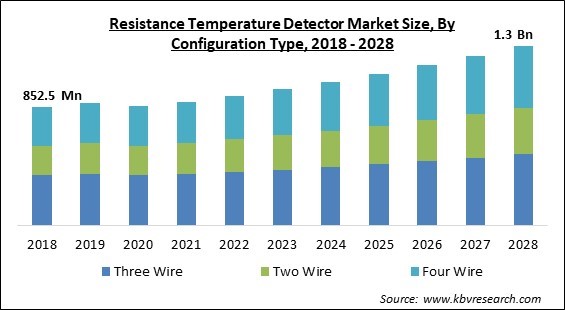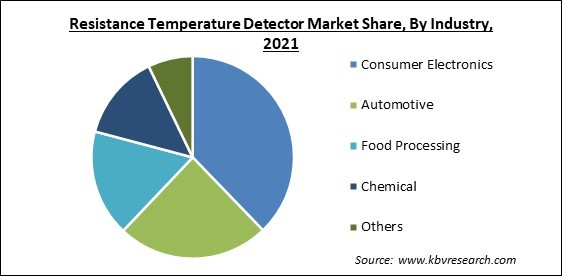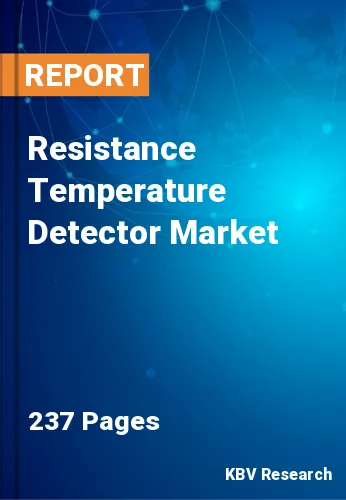The Global Resistance Temperature Detector Market size is expected to reach $1.3 billion by 2028, rising at a market growth of 5.6% CAGR during the forecast period.
An improved temperature sensing device constructed of metal, typically platinum is a resistance temperature detector. The RTD is available as a length of fine wire that has been encircled by a ceramic or glass core made of platinum nickel or copper. The temperature is measured by the resistance temperature detector sensor using the temperature/resistance connection of the wire. The market for resistance temperature detectors is also growing rapidly due to the increased need for electronic vehicle solutions.

Resistance temperature detector demand is increasing along with the demand for heating cables, which is supported by advancing urbanization to increase OEM demand. This industry is primarily driven by the advanced temperature monitoring system in electric vehicles (EV), which is also amplifying the demand for resistance temperature detectors. In addition, it is projected that rising investments in oil and gas pipeline expansion will fuel market trends for resistance temperature detectors.
Due to the rapid use of resistance temperature detector sensor solutions throughout the automotive sector, the growth of resistance temperature detector sensor solutions has been driven. The growth of resistance temperature detector sensor solutions has been driven by the rapid adoption of next-generation, cutting-edge radio temperature detector technology in the oil, gas, and government sectors, which has furthered the expansion of the resistance temperature detector sensor market.
Rising investments in the construction of oil and gas pipelines to support the market and rising demand for heating cables are important factors that affect the growth of the resistance temperature detector market. These factors are supported by advancing urbanization, which will increase OEM demand. Furthermore, the enhanced temperature monitoring system in EVs is likely to increase demand for RTD sensors and fuel market expansion.
The COVID-19 outbreak has had a significant negative impact on the growth of the resistance temperature detector market due to its severe effects on major market players. The demand for resistance temperature detector sensors has decreased in 2020 due to the shutdown of production operations by end-use industries such as the automotive and heavy industrial manufacturing sectors. Along with this, a disrupted supply chain lowers supply-side sales of the target product. In contrast to this, post-pandemic demand is predicted to increase for the least expensive resistance temperature detector sensor solution.
Temperature sensors are becoming more and more necessary as the requirement for Internet of Things (IoT) devices rises. Furthermore, as more mobile battery-powered IoT applications are developed, there is a growing demand for RTD sensors due to their flexibility and extremely low power requirements. The demand for air conditioners with IoT capabilities is also greatly increasing the demand for sophisticated RTDs for adjusting the compressor and room temperature. As a result, the market for digital RTD sensors is being significantly driven by the growing need for IoT platforms. The install base for IoT devices is expected to increase.

The accuracy, low energy consumption, long-term stability, and durability of the sensors in monitoring temperature are the main factors driving the worldwide RTD market. Furthermore, the automotive sector is seeing an increase in demand for RDP sensors for use in Advanced Driving Assistance Systems (ADAS) to enhance the security of both vehicles as well as passengers. Vehicle engines work at high temperatures; in these circumstances, thermal management is required to protect the vehicle and its occupants.
The designing of resistance temperature detectors is mostly preventing RTDs from becoming more commonly used. The design of RTDs is usually complex and necessitates attributes like stability, precision, and sensitivity. These sensors rely heavily on monitoring solutions in order to retain these features. Thus, in order to solve the design difficulties with the RTDs, this monitoring solution demands a highly skilled crew. RTDs can measure temperature accurately only if it does not fluctuate significantly. As a result, they can be applied to processes and reactions that have a repeatable steady-state.
By material type, the resistance temperature detector market is divided into platinum, nickel, copper and others. In 2021, the automotive industry segment covered a substantial revenue share in the resistance temperature detectors market. A passive market transition is currently occurring in the automotive industry. The growth of the automotive industry is being attributed to the emergence of the sharing economy and new alliances with disruptive tech firms. The temperature of the liquids and gases in a vehicle is sensed by the RTD sensors built into the vehicle.
Based on configuration type, the resistance temperature detector market is segmented into two wire, three wire and four wire. The four-wire segment generated a significant revenue share in the resistance temperature detector market in 2021. This is obviously the most sophisticated solution, and this is reflected in its price as well. They are mostly applied in lab settings where high accuracy is necessary. This circuit is useful because it can correct inaccuracies brought on by longer wire lengths between the measuring element and the measurement electronics.
On the basis of industry, the resistance temperature detector market is fragmented into food processing, automotive, chemical, consumer electronics and others. The nickel segment acquired a substantial revenue share in the resistance temperature detector market in 2021. The corrosion resistance of nickel resistance temperature detector sensors is good, and they are less expensive than platinum. The temperature of the Nickel range for nickel is only -80 to +260°C. These factors are expected to result in rising demand for nickel RTDs.
| Report Attribute | Details |
|---|---|
| Market size value in 2021 | USD 890 Million |
| Market size forecast in 2028 | USD 1.3 Billion |
| Base Year | 2021 |
| Historical Period | 2018 to 2020 |
| Forecast Period | 2022 to 2028 |
| Revenue Growth Rate | CAGR of 5.6% from 2022 to 2028 |
| Number of Pages | 237 |
| Number of Tables | 380 |
| Report coverage | Market Trends, Revenue Estimation and Forecast, Segmentation Analysis, Regional and Country Breakdown, Companies Strategic Developments, Company Profiling |
| Segments covered | Configuration Type, Industry, Material Type, Region |
| Country scope | US, Canada, Mexico, Germany, UK, France, Russia, Spain, Italy, China, Japan, India, South Korea, Singapore, Malaysia, Brazil, Argentina, UAE, Saudi Arabia, South Africa, Nigeria |
| Growth Drivers |
|
| Restraints |
|
Region-wise, the resistance temperature detector market is analyzed across North America, Europe, Asia Pacific and LAMEA. In 2021, the North America region accounted the maximum revenue share in the resistance temperature detector market. The U.S. in particular continues to play a prominent role in the resistance temperature detector sensor market. Major businesses and government agencies in the nation are heavily investing in technology. Due to the robust industrial and food processing sectors in this region, particularly in chamber applications, where temperature (cold) is typically the only parameter monitored, the North American region has a sizable share of the market.
Free Valuable Insights: Global Resistance Temperature Detector Market size to reach USD 1.3 Billion by 2028
The market research report covers the analysis of key stake holders of the market. Key companies profiled in the report include General Electric (GE) Co., ABB Group, STMicroelectronics N.V., Panasonic Corporation, Emerson Electric Co., Analog Devices, Inc., NXP Semiconductors N.V., Microchip Technology, Inc., Spectris PLC (Omega Engineering), and Kongsberg Group.
By Configuration Type
By Industry
By Material Type
By Geography
The Resistance Temperature Detector Market size is projected to reach USD 1.3 billion by 2028.
Growing Interest In The Internet Of Things (IoT) are driving the market in coming years, however, Obstacles Associated With The Design Of Rtds restraints the growth of the market.
General Electric (GE) Co., ABB Group, STMicroelectronics N.V., Panasonic Corporation, Emerson Electric Co., Analog Devices, Inc., NXP Semiconductors N.V., Microchip Technology, Inc., Spectris PLC (Omega Engineering), and Kongsberg Group.
The Platinum segment acquired maximum revenue share in the Global Resistance Temperature Detector Market by Material Type in 2021 thereby, achieving a market value of $414.2 million by 2028.
The Three Wire segment is leading the Global Resistance Temperature Detector Market by Configuration Type in 2021 thereby, achieving a market value of $516 million by 2028.
The North America market dominated the Global Resistance Temperature Detector Market by Region in 2021, and would continue to be a dominant market till 2028; thereby, achieving a market value of $462.2 million by 2028.
Our team of dedicated experts can provide you with attractive expansion opportunities for your business.

